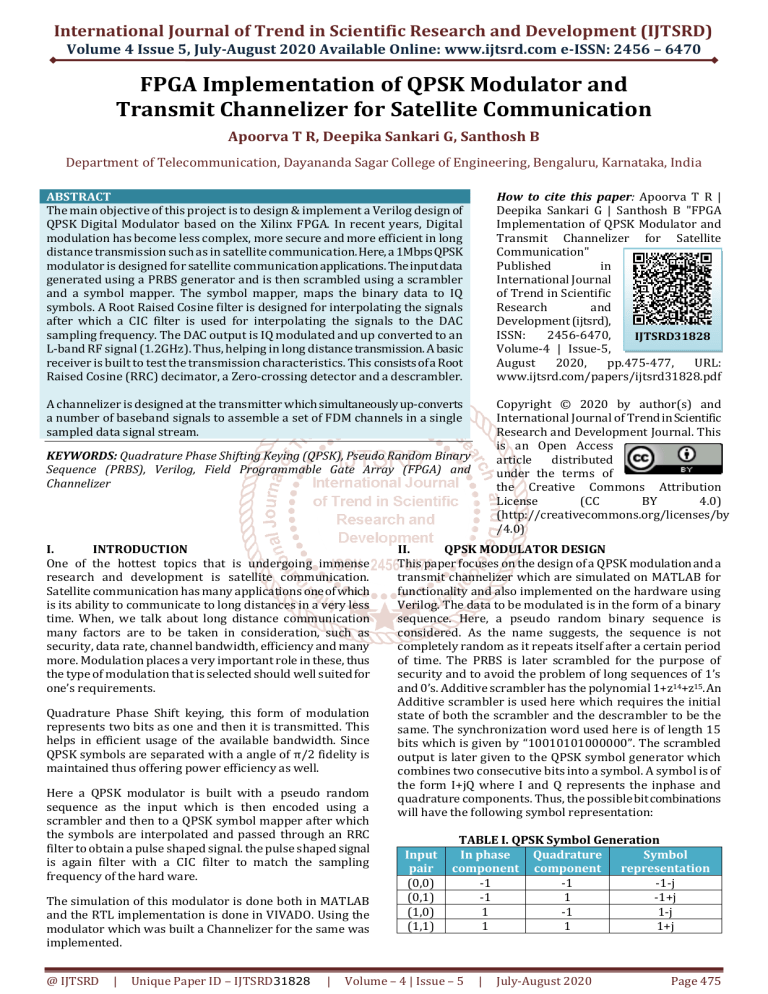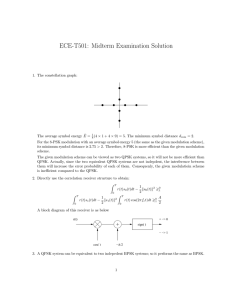
International Journal of Trend in Scientific Research and Development (IJTSRD)
Volume 4 Issue 5, July-August 2020 Available Online: www.ijtsrd.com e-ISSN: 2456 – 6470
FPGA Implementation of QPSK Modulator and
Transmit Channelizer for Satellite Communication
Apoorva T R, Deepika Sankari G, Santhosh B
Department of Telecommunication, Dayananda Sagar College of Engineering, Bengaluru, Karnataka, India
ABSTRACT
The main objective of this project is to design & implement a Verilog design of
QPSK Digital Modulator based on the Xilinx FPGA. In recent years, Digital
modulation has become less complex, more secure and more efficient in long
distance transmission such as in satellite communication. Here, a 1Mbps QPSK
modulator is designed for satellite communication applications. The input data
generated using a PRBS generator and is then scrambled using a scrambler
and a symbol mapper. The symbol mapper, maps the binary data to IQ
symbols. A Root Raised Cosine filter is designed for interpolating the signals
after which a CIC filter is used for interpolating the signals to the DAC
sampling frequency. The DAC output is IQ modulated and up converted to an
L-band RF signal (1.2GHz). Thus, helping in long distance transmission. A basic
receiver is built to test the transmission characteristics. This consists of a Root
Raised Cosine (RRC) decimator, a Zero-crossing detector and a descrambler.
How to cite this paper: Apoorva T R |
Deepika Sankari G | Santhosh B "FPGA
Implementation of QPSK Modulator and
Transmit Channelizer for Satellite
Communication"
Published
in
International Journal
of Trend in Scientific
Research
and
Development (ijtsrd),
ISSN:
2456-6470,
IJTSRD31828
Volume-4 | Issue-5,
August
2020,
pp.475-477,
URL:
www.ijtsrd.com/papers/ijtsrd31828.pdf
A channelizer is designed at the transmitter which simultaneously up-converts
a number of baseband signals to assemble a set of FDM channels in a single
sampled data signal stream.
Copyright © 2020 by author(s) and
International Journal of Trend in Scientific
Research and Development Journal. This
is an Open Access
article
distributed
under the terms of
the Creative Commons Attribution
License
(CC
BY
4.0)
(http://creativecommons.org/licenses/by
/4.0)
KEYWORDS: Quadrature Phase Shifting Keying (QPSK), Pseudo Random Binary
Sequence (PRBS), Verilog, Field Programmable Gate Array (FPGA) and
Channelizer
I.
INTRODUCTION
One of the hottest topics that is undergoing immense
research and development is satellite communication.
Satellite communication has many applications one of which
is its ability to communicate to long distances in a very less
time. When, we talk about long distance communication
many factors are to be taken in consideration, such as
security, data rate, channel bandwidth, efficiency and many
more. Modulation places a very important role in these, thus
the type of modulation that is selected should well suited for
one’s requirements.
Quadrature Phase Shift keying, this form of modulation
represents two bits as one and then it is transmitted. This
helps in efficient usage of the available bandwidth. Since
QPSK symbols are separated with a angle of π/2 fidelity is
maintained thus offering power efficiency as well.
Here a QPSK modulator is built with a pseudo random
sequence as the input which is then encoded using a
scrambler and then to a QPSK symbol mapper after which
the symbols are interpolated and passed through an RRC
filter to obtain a pulse shaped signal. the pulse shaped signal
is again filter with a CIC filter to match the sampling
frequency of the hard ware.
The simulation of this modulator is done both in MATLAB
and the RTL implementation is done in VIVADO. Using the
modulator which was built a Channelizer for the same was
implemented.
@ IJTSRD
|
Unique Paper ID – IJTSRD31828
|
II.
QPSK MODULATOR DESIGN
This paper focuses on the design of a QPSK modulation and a
transmit channelizer which are simulated on MATLAB for
functionality and also implemented on the hardware using
Verilog. The data to be modulated is in the form of a binary
sequence. Here, a pseudo random binary sequence is
considered. As the name suggests, the sequence is not
completely random as it repeats itself after a certain period
of time. The PRBS is later scrambled for the purpose of
security and to avoid the problem of long sequences of 1’s
and 0’s. Additive scrambler has the polynomial 1+z14+z15. An
Additive scrambler is used here which requires the initial
state of both the scrambler and the descrambler to be the
same. The synchronization word used here is of length 15
bits which is given by “10010101000000”. The scrambled
output is later given to the QPSK symbol generator which
combines two consecutive bits into a symbol. A symbol is of
the form I+jQ where I and Q represents the inphase and
quadrature components. Thus, the possible bit combinations
will have the following symbol representation:
Input
pair
(0,0)
(0,1)
(1,0)
(1,1)
TABLE I. QPSK Symbol Generation
In phase
Quadrature
Symbol
component component
representation
-1
-1
-1-j
-1
1
-1+j
1
-1
1-j
1
1
1+j
Volume – 4 | Issue – 5
|
July-August 2020
Page 475
International Journal of Trend in Scientific Research and Development (IJTSRD) @ www.ijtsrd.com eISSN: 2456-6470
Once the symbols are generated, they are mapped onto the
plane with Inphase component along the X-axis and
Quadrature component along the Y-axis. Hence there are
four symbols present, one in each quadrant with a
separation of 900. These symbols are later filtered using a
Root Raised Cosine Interpolation filter. The filter has a rolloff factor of 0.25, with a span of 8 and containing 8 samples
per symbol. The symbols are first interpolated by a factor of
8, in order to increase the number of samples and also to
prevent Inter Symbol Interference (ISI). The next step would
be to convolute the interpolated signal with the filter coefficient. This will result in a pulse shaped signal which can
be transmitted through a channel.
In order to verify, if the same input bits are received after the
demodulation process, a basic receiver is designed. The first
procedure at the receiver is the Root Raised Cosine
Decimation. Here the first step is to convolute the pulse
shaped signal with the same filter co-efficient which was
used at the transmitter. After this process, the convolution
overheads are filtered out and hence the number of samples
will be same as that obtained after the interpolation process.
The next step is the decimation process, where in the
sampling rate is reduced by decimating by a factor of 8,
which is the process of getting every eighth sample from the
output. The output of the decimation process corresponds to
the symbols that were interpolated. The de-mapping of these
symbols will result in a binary sequence. This binary
sequence is equivalent to the scrambled output. Thus, the
binary sequence upon descrambling which uses the same
synchronization word as the scrambler will give the input
fed to the system which is the Pseudo Random Binary
Sequence.
III.
CHANNELIZER DESIGN
Bandwidths are very expensive; hence the only wise choice
is to use the available bandwidth to its full potential. This can
be done by using a channelizer that lets us pass many signals
at different frequencies using the same bandwidth that is
available. For simulation, same signals that were generated
using the QPSK modulator will be used. Two signals will be
generated using two different symbol rates. After generation
of two signals, one of the two signals will be multiplied by
different sine waves so that they will have different
frequencies. Here the aim is to create signals that will be
centered at frequencies 400 KHz, 800 KHz,1200KHz and at
1600 KHz. The MATLAB simulation and the RTL synthesis is
shown below in figures 2 and figure 5.
IV.
TESTBENCH
Test benches come in very handy as the input need not to be
individually forced each time, we run a simulation. Thus,
reducing time and man power required for every simulation
that has to be run. The first step in writing a test bench is to
define all the parameters with their respective sizes, that will
be used includes clock, valid and the other inputs and the
outputs of each module.
The initial values of reset and valid have to be defined. The
reset is initialized keeping in mind in which condition the
system goes into the reset condition, i.e. if it is active high
then system goes under reset if the input is ‘1’ or if it active
low then the system goes into reset when the input is ‘0’. The
clocks that are needed for each module to run is created
usually using a clock divider which is by simply using a
@ IJTSRD
|
Unique Paper ID – IJTSRD31828
|
counter or a clock divider that is available in Vivado. After
which instances for each module is created as required and
connected using the wires which were predefined. It is very
important that the size of the output of one module that is
connected as the input to the other are same.
V.
HARDWARE IMPLEMENTATION
Here, a Xilinx ZC706 Evaluation Board is used which has a
chip inside, ZynQ XC72045. ZynQ is a SoC (system on chip)
which is, the system has both the FPGA and an ARM
processor which is dual core. To the Xilinx evaluation board,
the Analog Devices Evaluation board will be connected
through the FMC port which has a chip named AD9361. This
evaluation board is called the FM COMMS2. This is a RF
Transmitter-Receiver which includes ADC, DAC, RF upconverter and so on. The FM COMMS2 consists of two RF
transmitter-receiver pairs. Since this paper is based on a
transmit channelizer, the cable is connected from the
transmitter of one of the Tx-Rx pairs to the spectrum
analyzer.
VI.
RESULTS
Simulation on MATLAB gives us the functionality of the
system. The above process was simulated on MATLAB and
the results are as follows.
In MATLAB, the symbols are processed as complex numbers
with inphase component being the real part and quadrature
component being the imaginary part. Upon QPSK modulation
the following output is obtained.
In the output shown in the figure 1, the first figure indicates
the PRBS sequence that is fed as the input. The second figure
represents the Root Raised Cosine filter coefficients. The
third figure represents the pulse shaped signal and the last
one represents the data recovered.
Fig.1. QPSK Modulation and Verification in MATLAB
The pulse shaped signal after being passed through the CIC
filter, as seen in the figure 2, the signal at the center is at a
symbol rate of 100kHz and the remaining four signals are at
a symbol rate of 200kHz which are multiplied with sine
waves of frequencies 400kHz,800kHz,1200kHz and 1600kHz
respectively and added. This is done in order to transmit all
the five signals through the same channel with a frequency
separation of 400kHz.
Volume – 4 | Issue – 5
|
July-August 2020
Page 476
International Journal of Trend in Scientific Research and Development (IJTSRD) @ www.ijtsrd.com eISSN: 2456-6470
Figure 4: Channelizer
The hardware implementation of the above gives the
following results.
Fig.2. Transmit Channelizer output
In case of Verilog, the QPSK modulation is performed and the
figure 3, shows the pulse shaped signal and the verification
of the process. The output shows the following: reset, clocks
at different frequencies, valid input, Inphase and Quadrature
components of a symbol, and the pulse shaped signal
truncated to 16 bits (I_tx and R_tx),decimated inphase and
quadrature components, bits recovered from the decimated
signal(I and Q bits), scrambled data, combined I and Q bits,
input PRBS and descrambled output in order.
In case of Verilog, the sine waves are generated using the
coefficients obtained in MATLAB and multiplied with the
pulse shaped signal having a symbol rate of 200kHz. For the
signal with symbol rate of 100kHz the output of the CIC filter
serves as the output. In case of Verilog as the inphase and
quadrature components are dealt with separately, the
respective I and Q components of the five signals are added
separately.
Figure 5: Spectrum analyzer output
REFERENCES
[1] Amean Al safi and Bradley Bazuin, “FPGA Based
Implementation of BPSK and QPSK Modulators using
Address Reverse Accumulators”, IEEE,2016.
[2] Akhil Khanna, Anju and Harsh Jain” Design and
Synthesis of Bandwidth Efficient QPSK Modulator for
Low Power VLSI Design”, Jaiswal ICECS 2015.
[3] K. Mounica, S. Mohan Das P. Uday Kumar.” A Verilog
Design in FPGA Implementation of Quadrature Phase
Shift Keying (QPSK) Digital Modulator”, International
journal of engineering sciences and research
technology, 2013.
Fig.3. QPSK Modulation and Verification in VERILOG
The figure 4 represents the inphase components of the five
signals. As these signals are obtained after multiplying with a
sine wave, the signal has an envelope of a sine wave. The
quadrature components are also processed in the same way
as the inphase components and hence it looks similar to the
figure 4. Later, these inphase and quadrature components
serve as the input to the hardware.
[4] Vishakha Pareek School “A Novel Implementation of
QPSK Modulator on FPGA”, 2016.
[5] Wenmiao Song & Qiongqiong Yao. “Design and
Implement of QPSK Modem Based on FPGA” IEEE,
2010.
[6] Digital Design, an embedded systems Approach using Peter J. Ashenden.
[7] Digital Signal Processing, 5th edition - by V. K. Ingle and
J. G. Proakis.
[8] MATLAB and its applications in Engineering by Raj
Kumar Bansal, Ashok Kumar Goel, Manoj Kumar
Sharma.
@ IJTSRD
|
Unique Paper ID – IJTSRD31828
|
Volume – 4 | Issue – 5
|
July-August 2020
Page 477




